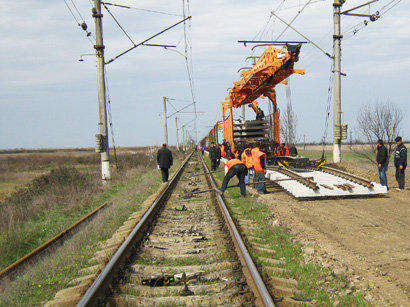
‘Railroad Wars’ Intensify in South Caucasus
Publication: Eurasia Daily Monitor Volume: 14 Issue: 102
By:

The competition between two rail corridor projects in the South Caucasus—the north-south one, long promoted by Moscow, and the east-west one backed by China, Central Asia and the West—has been intensifying. Recently, one Armenian analyst has gone so far as to speak about the outbreak of “railroad wars” in the region, a term of art seldom used anywhere since the years before World War I in the Ottoman Empire and the Middle East more generally (Iarex.ru, July 27, 28, 31).
But if the term seems anachronistic, it is fully applicable today argues Vage Davtyan, a researcher at the Slavic University in Yerevan. As he notes, the outcome of this competition will determine the geopolitical futures not just of the three countries in the region—Armenia, Azerbaijan and Georgia—but also that of their respective backers, who will either win big or lose big as a result. The political problems that must be overcome and the enormous sums of money that must be found to realize either the north-south or the east-west corridor are profound. And this makes it difficult to predict which transit corridor will win, Davtyan suggests (Iarex.ru, July 27). As a result, one country in the region, Azerbaijan, is trying to hedge its bets by seeking to participate in both projects (Iarex.ru, July 28).
Until the collapse of the Soviet Union, the north-south corridor was the only game in town, Davtyan says. The Russians ran a rail line along the western shore of the Caspian already in the 19th century, hoping to gain access to Persia; and the Soviets added a second line on the shore of the Black Sea in 1942, in order to secure military assistance from the Western allies. Moscow developed the rail network of each of the three republics in the region in terms of that north-south imperative. And by the end of Soviet times, Moscow had electrified almost all of this regional rail network except for two segments in Armenia (Iarex.ru, July 27).
With the disintegration of the Soviet Union, the three newly independent South Caucasus countries were forced to adapt to “new economic realities and develop their own tariff policies.” But each of these was complicated by the Karabakh war, the closure of the Armenian-Turkish border, and the conflicts between Georgia and Abkhazia and South Ossetia. Moreover, they were further challenged by the entrance of the United States, the European Union and China as extra-regional players who promoted an east-west rail line corridor just as they had backed the construction of east-west pipelines previously (Iarex.ru, July 27).
The disruption of Soviet-era rail connections, Davtyan points out, had unexpected consequences. First of all, shippers could not move cargo along the entire route by rail alone, and thus they shifted to intermodal means. Second of all, that shift boosted the cost of moving raw materials, goods and people in the region. Davtyan gives the following example: it now costs more to move cargo from the Georgian port of Poti to Yerevan than it does to ship the same cargo from China to Poti in the first place. Unless this problem is addressed, he says, it will hold back the economy not only of Armenia but of Georgia and Azerbaijan as well (Iarex.ru, July 28).
Yerevan has looked to Moscow and its north-south project for the last decade, even to the point of allowing Russian Rail to take effective control of Armenian rail lines. But Russia lacks the funds to build the north-south route on its own. Iran initially promised to pay for much of it but has now rescinded that offer. And as a result, Yerevan has been more open to taking part in east-west projects, something that would require some resolution of the Karabakh dispute with Baku. That is unlikely to happen anytime soon, but Yerevan’s new willingness to think about the east-west project shows that the situation in this railway war, as stagnant as it may appear to outsiders, is having an effect (Iarex.ru, July 28).
Continuing the “balanced” foreign policy approach of former president Heydar Aliyev, Baku is also interested in being part of both these projects, and is in a better position than Yerevan or Tbilisi to provide financing. Indeed, at least since 1998, the Azerbaijani authorities have seen their country as the natural intersect point between the north-south line Russia wants and the east-west one China and the West would prefer (Iarex.ru, July 31).
But Azerbaijan faces potential competition from a different north-south corridor than the one it now sits astride. Moscow, Yerevan and Tehran are discussing the possibility of building a rail link between Iran and Armenia, one that would become “a potential competitor of the Kazvin–Resht–Astara road.” At present, this project, which is estimated to have a $3 billion price tag, is on hold because of economic difficulties in Russia and Iran and because of uncertainties about the reopening of rail connections between Georgia and the Russian Federation. Without that happening, an Iranian rail link into Armenia alone would not be profitable (Iarex.ru, July 31).
Because of these financial difficulties and because the various military-political and ethno-national conflicts in the south Caucasus threaten to keep that region a wall rather than a bridge for outsiders, neither of the competing rail projects may be fully built anytime soon. But articles like Davtyan’s suggest that just below the surface, there are serious economic and political struggles going on. And as economic and political divides deepen, they are becoming more rather than less serious in this new “railroad war.”



